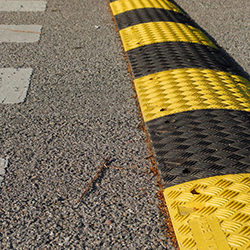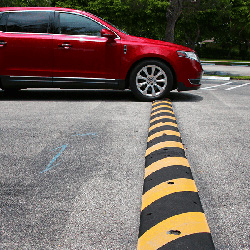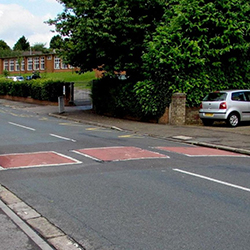The Benefits of Speed Bumps and Speed Humps in Reducing Car Accidents
What are speed bumps and speed humps?
Speed bumps and speed humps are traffic calming devices that are commonly used to slow down vehicles and improve road safety. They are physical raised structures placed on the road surface, designed to force drivers to reduce their speed. Speed bumps are typically shorter and steeper, while speed humps are longer and more gradual. Both types of devices are usually made of asphalt or concrete and are marked with reflective paint for increased visibility. Speed bumps and speed humps are often installed in areas with high pedestrian activity, such as school zones, residential neighborhoods, and parking lots, to ensure the safety of pedestrians and prevent accidents. Continue reading “The Benefits of Speed Bumps and Speed Humps in Reducing Car Accidents” »Speed bumps Versus Speed humps, what is the difference?
Traffic safety is of heightened importance when the people and automobiles are in close proximity. It is always a safety issue for the pedestrians near the parking lots, hospitals, schools and multi use zones. In this context, reducing the speed is the only way available to protect people’s lives from rapid driving. Slower traffic speeds minimize both the chances of an accident and the possibility of death should one occur.


To promote cautious driving in pedestrian zones, both speed bumps and humps are effective.
Speed zones are often put up to promote safe driving. Still, since the written restrictions are often forgotten or ignored, the physical design of the highway or surrounding environment is typically used to reduce traffic congestion in these locations. Speed bumps and speed humps are vertical traffic control barriers that bump in the road that cause the passengers of a car traveling too rapidly over them to be jolted awake. According to statistics, they are the most often employed structural traffic calming components on the road today. They may be composed of various materials, including asphalt, concrete, plastic, rubber, and metal. These measurements are linked and have many of the same advantages; yet, they are not interchangeable solutions; they are each good for a specific application in their own right.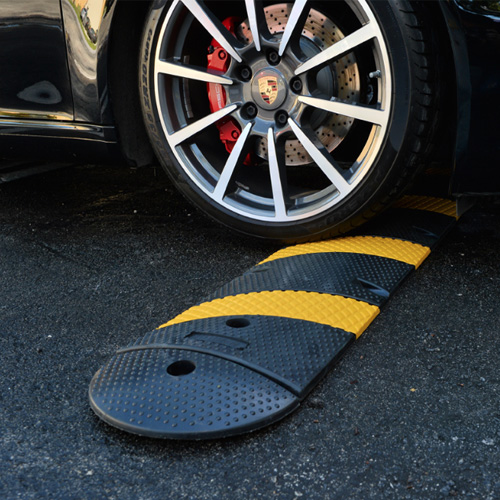
6’ Economy Recycled Rubber Heavy Duty Speed Bump
Premium Recycled Rubber Safety-Striped Speed Hump – Reflective Rubber
Recycled Rubber Speed Hump – Yellow / Black Single Lane or Double Lane
Heavy Duty Rubber Speed Hump – Yellow / Black – Low Profile Speed Bump
| SKU | Description | Length | Height | Width | Weight |
|---|---|---|---|---|---|
| SB206FT | 6 Ft Speed Bump (1) 6′ Section With no End Caps | 72″ | 2″ | 12″ | 48.40 |
| SB207FT | 7 Ft Speed Bump (1) 6′ Section + (2) End Caps | 86″ | 2″ | 12″ | 55.40 |
| SB213FT | Single Lane 12 Ft Speed Bump (2) 6′ Section With no End Caps | 144″ | 2″ | 12″ | 96.80 |
| SB219FT | Double lane 19 Ft Speed Bump (3) 6′ Section + (2) End Caps | 230″ | 2″ | 12″ | 152.20 |
| SB225FT | 25 Ft Speed Bump (4) 6′ Section + (2) End Caps | 302″ | 2″ | 12″ | 200.60 |
| SB2ECAP | End cap | 7′ | 2′ | 12′ | 3.50 |
| SKU | Description | Length | Height | Width | Weight |
|---|---|---|---|---|---|
| SB3039I | 39″ Speed Bump (1) 39″ Section With no End Caps | 39″ | 2″ | 13.7″ | 36.20 |
| SB3117I | 117″ Single Lane Speed Bump (3) 39″ Sections With no End Caps | 117″ | 2″ | 13.7″ | 108.60 |
| SB3137I | 137″ Single Lane Speed Bump (3) 39″ Sections + (2) End Caps | 137″ | 2″ | 13.7″ | 124.20 |
| SB3234I | 234″ Double lane Speed Bump (6) 39″ Sections With no End Caps | 234″ | 2″ | 13.7″ | 217.20 |
| SB3254I-2 | 254″ Double Lane Speed Bump (6) 39″ Sections + (2) End Caps | 254″ | 2″ | 13.7″ | 232.80 |
| SB3ECAP-2 | End cap | 10″ | 2″ | 13.7″ | 7.80 |
| SKU | Description | Length | Height | Width | Weight |
|---|---|---|---|---|---|
| SH1018I | 18.75″ Speed Bump (1) 18.75″ Section with no End Caps | 18.75″ | 1.25″ | 2″ | 22.20 |
| SH1112I | 112.5″ Single Lane Speed Bump (6) 18.75″ Sections with no End Caps | 112.5″ | 1.25″ | 2″ | 133.20 |
| SH1128I | 10 Ft Single Lane Speed Bump (6) 18.75″ Sections + (2) End Caps | 128.5 | 1.25″ | 2″ | 148.80 |
| SH1225I | 225″ Double Lane Speed Bump (12) 18.75″ Sections with no End Caps | 225″ | 1.25″ | 2″ | 266.40 |
| SH1241I | 20 Ft Double Lane Speed Bump (12) 18.75″ Sections + (2) End Caps | 241″ | 1.25″ | 2″ | 282.00 |
| SH1ECAL | LEFT End Cap | 8″ | 1.25″ | 2′ | 7.80 |
| SH1ECAR | RIGHT End Cap | 8″ | 1.25″ | 2′ | 7.80 |
| SKU | Description | Length | Height | Width | Weight |
|---|---|---|---|---|---|
| SH2019I | 19.75″ Speed Bump (1) 19.75″ Section With no End Caps | 19.75″ | 2″ | 3″ | 48.00 |
| SH2121I | 10 Ft Single Lane Speed Bump (5) 19.75″ Sections + (2) End Caps | 121.75″ | 2″ | 3″ | 273.00 |
| SH2240I | 20 Ft Double Lane Speed Bump (11) 19.75″ + (2) End Caps | 240″ | 2″ | 3″ | 561.00 |
| SH2ECAL | LEFT End cap | 11.5″ | 2″ | 3′ | 16.00 |
| SH2ECAR | RIGHT End cap | 11.5″ | 2″ | 3′ | 16.00 |
Speed Humps:
On minor streets or connection roads, traffic has to move smoothly, but excessive speed may harm people, they are often observed. A speed hump, also known as road humps or undulations, is a traffic control device used in 10–15 mph zones. These are often used in traffic control in playgrounds and school zones. When a vehicle passes over a speed hump at the legal speed limit, it will experience a moderate rocking feeling in the automobile. If a car is traveling at a hazardous pace, the hump will jolt the vehicle and its contents, causing pain to the people and inflicting damage to the cargo. These obstructions often extend beyond the confines of the lane in which they are installed. Encouraging cars to pass over them with both wheels reduces the probability of a vehicle bottoming out. Speed humps are available in several different profiles and travel lengths. These considerations impact the sensation of pain caused by the fast vehicle. The distance traveled ranges between 3 and 20 feet. There is just one up-and-down motion created by a journey length longer than the vehicle, but a travel length less than the vehicle causes two rocking motions when each pair of wheels passes over. Most of the time, speed humps are positioned in a sequence to maintain the speed restriction throughout a lengthy stretch. They are not suitable for main highways, emergency routes, or any roadway where a motorist may easily avoid the hump by driving on the shoulder. The result is that most of the time, they’re built-in one or two-lane small urban settings with curbs and closed sewers. Whenever speed humps are built in regions with a shoulder, they are sometimes paired with bollards or other obstructive measures to prevent automobiles from off the route.Speed bumps
When compared to speed humps, speed bumps are more forceful traffic calming solutions. As a result, they are excellent in areas where pedestrians and automobiles share space closely, such as parking lots and driveways. A speed bump often slows traffic down to 2–10 mph, providing both people and automobiles enough time to respond safely to one another when they come into contact. Because they require vehicles to come to a near stop to pass over them, speed bumps are seldom utilized on public roads, and they may cause harm to vehicles traveling at standard speeds. Speed bumps may range in height from two to four inches, although they go over a far shorter distance than speed humps do. These obstructions lie beneath a vehicle’s tire for less than half of a whole wheel revolution, and their normal widths range from six inches to two feet in length. The height causes a sudden bounce in a vehicle to travel distance ratio, which may cause both people and cargo to be shaken. Because a speed bump is always far smaller than the cars traveling over it, each axle will cross individually, resulting in a car traveling at excessive speed receiving two significant jolts. Like their more sedate cousins, speed bumps may be put at regular intervals to keep the speed decrease consistent. They are generally placed at strategic intervals because they are more unpleasant to drive over at any speed and serve a limited geographic region. Speed bumps can deliver a jolt, which may explain why they have earned a variety of amusing nicknames across the globe. They are referred to as “dos-d’âne” in French, which means “humpback” in English. They are referred to as speed breakers in India, judder bars in New Zealand, sleeping policemen in the United Kingdom, and road turtles in the United States (Southern US).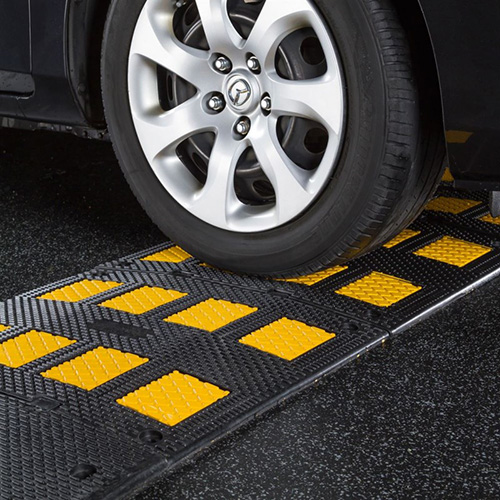
Benefits & Cautions:
One of the most significant advantages of speed bumps and humps is that they retain their effectiveness as a deterrent regardless of how acclimated drivers get to their presence. For a short period, flashing signs or intermittent traffic enforcement might alter motorist behavior, but drivers often return to their former habits. One may choose to ignore a sign, but one cannot ignore the road underneath it. A speed hump or a speed bump causes the same pain for a motorist traveling too rapidly, regardless of whether it is their first or hundredth time passing over one. A bump in the road is not always the best solution for calming traffic situations. Obstacles operate best when the driver is aware that they are approaching and begins to slow down before reaching the obstacle’s edge. Speed bumps and humps are often carefully marked with contrasting colors or reflective surfaces to promote visibility. Still, they must also be located in areas where drivers will see them approaching to be effective. Use of these devices amid a lengthy curve or on streets with grades more than 8 percent is not recommended. A steep incline may also alter the effective height of a speed hump or bump, causing it to have a greater impact than it was originally designed to have. Visibility may also be a problem in certain winter climes, particularly in areas where snowfall is heavy and local roads are not plowed. On arterial or emergency routes where they might pose a safety threat, speed humps and bumps are likewise not advised for installation. A motorist may lose control of his or her car if these obstacles are encountered unexpectedly or while traveling at excessive speeds. However, the most flexible instruments in the traffic management toolkit are those that are utilized in the correct context.Materials and installation
Depending on their purpose, speed bumps and humps are often built of rubber or asphalt. Various materials such as plastic, metal, and concrete are also available. These obstacles, often composed of rubber or plastic, are simple to put on pre-existing surfaces, allowing for a quick and efficient set-up. Both solutions are lightweight and may be deployed just for a short period. Snow removal in winter regions may be difficult by very restricted installations, particularly when several of them are put near together in series. Both rubber and plastic speed bumps can be removed to make these procedures more convenient. As rubber has higher compression than asphalt or concrete, it may be advantageous to a vehicle that strikes it too rapidly, at an angle, or when it is low to the ground, as the vehicle is less likely to sustain damage as a result of the impact. Because of the increased compression, rubber obstacles of the same height are less efficient at delaying traffic than identical asphalt installations. As a result, rubber or plastic obstacles are not recommended for highways where heavy industrial traffic is constantly passing. On the other hand, Rubber is strong and long-lasting under typical circumstances, and it is affordable to purchase and install. Municipal road workers or private paving firms are often tasked with installing asphalt or concrete speed humps. They must be precise and knowledgeable in the field, or else the installation might go wrong. In the hands of suitably skilled staff, asphalt may be used to create obstacles with certain shapes and travel lengths. Because both materials have less compression than rubber or plastic, they are marginally more successful at speed reduction than the other. On the other hand, asphalt and concrete will tend to wear and break over time and under various weather conditions.Bottom Line:
To promote cautious driving in pedestrian zones, both speed bumps and humps are effective. Speed humps are beneficial in locations where traffic must move quickly, while speed bumps are good in tiny spaces where people and vehicles share space more evenly. Both need less preparation than other physical traffic calming systems such as roundabouts or one-way streets, and modular, prebuilt versions may be put quickly and cheaply on existing surfaces. Roundabouts and one-way streets are examples of such approaches. When placed in the proper context, larger speed humps and their smaller but more aggressive siblings, speed bumps, maybe traffic safety superstars when used properly.List of websites with governmental information about speed bumps in the USA:
- Federal Highway Administration (FHWA): The FHWA is a division of the US Department of Transportation, responsible for overseeing the use of speed bumps on federal highways and roadways. Their website contains guidelines and regulations for the use of speed bumps on these roads.
- State Departments of Transportation: Each state has its own department of transportation, responsible for overseeing the use of speed bumps on state-owned roads and highways. Websites for these departments may contain information about regulations and guidelines for speed bumps in their respective states.
- City and County Government Websites: Many cities and counties have their own transportation departments, responsible for overseeing the use of speed bumps on local roads. Websites for these departments may contain information about regulations and guidelines for speed bumps in their respective areas.
- National Institute for Occupational Safety and Health (NIOSH): NIOSH is a division of the Centers for Disease Control and Prevention (CDC), responsible for studying and promoting workplace safety. Their website contains information about the use of speed bumps in workplace settings, including guidelines for their installation and use.
- Occupational Safety and Health Administration (OSHA): OSHA is a division of the US Department of Labor, responsible for promoting workplace safety. Their website contains information about the use of speed bumps in workplace settings, including guidelines for their installation and use.
Websites:
- Federal Highway Administration (FHWA): https://www.fhwa.dot.gov/
- State Departments of Transportation: You can find a list of state transportation departments and their respective websites here: https://www.transportation.gov/state-transportation-links
- City and County Government Websites: The websites for individual cities and counties can vary, but you can typically find them by doing a Google search for the name of the city or county followed by “department of transportation.”
- National Institute for Occupational Safety and Health (NIOSH): https://www.cdc.gov/niosh/index.htm
- Occupational Safety and Health Administration (OSHA): https://www.osha.gov/
Who invented humps?
Introduction
Welcome, dear reader, to our journey back in time, as we explore the history and influence of one of the most common traffic calming techniques, the humble hump. As the number of motor vehicles increased and roads became more crowded, humps emerged as an essential tool in the battle against road accidents. These simple yet effective traffic controllers held the reins, slowing down the mad rush of vehicles. Continue reading “Who invented humps?” »What are speed bumps?
Speed bumps, also known as speed humps, are traffic calming devices that are designed to slow down vehicles. They are typically made of asphalt or concrete and are raised sections of the road that force drivers to slow down. Speed bumps are commonly used in areas where there is a high volume of pedestrian traffic, such as school zones, residential areas, and parking lots. They are also used on roads with sharp turns or steep inclines to prevent accidents. Speed bumps come in various sizes and shapes, but they all serve the same purpose of reducing vehicle speed.
Continue reading “What are speed bumps?” »
Can I put a speed bump in front of my house?
Introduction
Have you ever lay awake at night, disturbed by the screeching tires of cars speeding down your street? Perhaps that’s led you to question, “Can I put a speed bump in front of my house?” Well, the journey to safer streets isn’t as straightforward as one might hope. Continue reading “Can I put a speed bump in front of my house?” »What are the disadvantages of speed bumps?
Introduction
Speed bumps, those ubiquitous humps of asphalt that pepper our roads, are commonly seen as an indispensable tool in traffic management. They’re installed with the noblest of intentions – to reduce accidents and enhance pedestrian safety. But, what if these well-intentioned guardians of the tarmac are not as benign as they seem? Our focus in this article is to shed light on the potential adverse effects of these traffic calming devices. From heightened noise levels to escalated fuel consumption and vehicle damage, we’ll be delving into the not-so-obvious downside of speed bumps. So, buckle up for a bumpy ride as we navigate the lesser-known terrain of traffic control. Continue reading “What are the disadvantages of speed bumps?” »What is the difference between speed bumps and humps?
Introduction
For anyone navigating the world of traffic calming measures, the terms speed bumps and speed humps are likely to cross your path. It’s easy to assume they are interchangeable, but understanding their distinct differences is crucial when making decisions about roadway safety. Just like a cake and a pie are both desserts yet very different, speed bumps and humps both moderate vehicle speed, but they do it in different ways. This article aims to help you distinguish between the two, explaining the unique benefits and drawbacks of each approach, so that you can make a well-informed choice. Buckle up and let’s delve into the world of traffic calming measures! Continue reading “What is the difference between speed bumps and humps?” »What happens if you go over a speed bump too fast?
Introduction
Welcome to the world of speed bumps and speed humps! Ever noticed those slight elevations on the road that force you to decelerate? Those are what we call speed bumps and humps. They are considerably smaller than mountains, yet they command the power to control speed! Continue reading “What happens if you go over a speed bump too fast?” »Speed Control on Roads: Enhancing Safety with Speed Bumps, Humps, and More
Every year, thousands of accidents on roads across the globe are attributed to excessive speed. Speeding not only increases the likelihood of accidents but also magnifies their severity. In this article, we delve into the crucial role of speed control in enhancing road safety, focusing on the effectiveness of speed bumps and humps, and exploring other traffic calming measures. Understanding these approaches can be instrumental in making our roads safer for drivers, passengers, and pedestrians alike.
Continue reading “Speed Control on Roads: Enhancing Safety with Speed Bumps, Humps, and More” »




